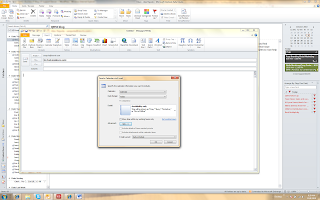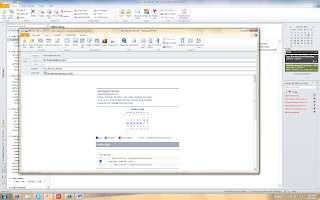
by Colin MacDonald
I have noticed the past few months a lot of clients getting viruses on their machines.There hasn’t been the usual scare of “OH NO! Look out, there’s a worm virus attack happening!!” and everyone freaks out, it’s just a normal day in the virus world. As it affects me and the amount of work that I do, I wanted to find out how they were getting these viruses and then come up with a few easy ways to prevent them. I decided to look at their emails, all these steps I have implemented at at least 1 company, with most of them scattered throughout other clients.
1. Problems
Attachments – Of course everyone should be wary of opening attachments in emails. If it’s a video or pictures, it may be infected with malware or a virus.
Forwards – The funny jokes and touching stories that people share online. You can tell that you’re getting these by the “fwd fwd fwd fwd…..” in the subject line. I personally don’t read forwards. It’s that easy of a choice to make. For the 30 seconds that I may chuckle or feel good about reading what the story was, it’s not worth the 3 hours worth of work that I must do to clean my computer of infections
Fake Emails – Is your brother the kind of guy that would write you an email that says “Hello. Check this out! www.infectmypcbecausethisisafakeemailwithafakelink.com”? Or would your brother be more like mine and say “Hey punk. I saw this video and thought of you and that time when that basketball hit you in the face (note: that totally never happened in our childhood, I was a way better ball player than he was) and I laughed until I couldn’t breathe. www.realvideobutIwasnotthebrotherwhogothitintheface.com. Which one of those links would you click on? Figure out what is real and what isn’t. Spammers will try and trick you into opening their emails by sounding legit. Subject lines will say things “Good seeing you the other day” “Want to do lunch tomorrow?” “Check out this website that I found!”. Some will go as far as to enter in your name to try and personalize it even more, thus getting you to click on it.
With all the social networking sites out there, you are bound to be one of the millions using them informing the world of your thoughts in up the minute broadcasts. These sites have a system where notification emails can be sent to you. Spammers will try and mimick these also. Facebook will send you a notification using the email address notification@facebook.com. Spammers will use the address notifications@facebookmail.com. The trick is to know which of these are real and which aren’t.
2. Solutions
Outlook Reading Pane – Outlook has a function where it will automatically open your individual emails when highlighted. This can pose a risk in the sense that highlighting an infected email will automatically open it thus infecting the computer. My advice is to turn it off. That way if you need to read an email, you must double click on it.
Setup an alternate email address – Don’t ever sign up for anything using your business email. There are plenty of free email sites out there to use. Some of the more popular ones: www.hotmail.com, www.yahoo.com and my personal favourite www.gmail.com. Tell your friends to send forwards (if you’re one of those who absolutely needs to read them) to it. That way if your email account starts to spam, it won’t be from your company email (your system administrator will thank you for that).
When signing up for other things (such as Facebook, fantasy football, software trials) use this email address, if you’re added to a spam list, you don’t see all of the messages about getting Viagra that are gonna come to you, because you’ll get enough of those already from that sales guy you upset that one time who uses your email address to sign up for every credit card and magazine offer he gets.
Notification emails – In regards to the Facebook notifications, it’s simple enough. If you get an email from Facebook saying how Aunt Peggy just commented on a photo of you (hopefully not the photo of the last party you went to…) delete the notification email, open a new browser window and log into your Facebook account through it’s main page. Sure, that email has a link in it, but what if you were too late to see that it was from a fake email address?
Now these aren’t going to prevent any user from ever getting a virus or malware on their machine. However, these are just a few of the little things that I have seen from my years in the IT business. In the end it boils down to common sense about what you do online and what you open in your email
I have noticed the past few months a lot of clients getting viruses on their machines.There hasn’t been the usual scare of “OH NO! Look out, there’s a worm virus attack happening!!” and everyone freaks out, it’s just a normal day in the virus world. As it affects me and the amount of work that I do, I wanted to find out how they were getting these viruses and then come up with a few easy ways to prevent them. I decided to look at their emails, all these steps I have implemented at at least 1 company, with most of them scattered throughout other clients.
1. Problems
Attachments – Of course everyone should be wary of opening attachments in emails. If it’s a video or pictures, it may be infected with malware or a virus.
Forwards – The funny jokes and touching stories that people share online. You can tell that you’re getting these by the “fwd fwd fwd fwd…..” in the subject line. I personally don’t read forwards. It’s that easy of a choice to make. For the 30 seconds that I may chuckle or feel good about reading what the story was, it’s not worth the 3 hours worth of work that I must do to clean my computer of infections
Fake Emails – Is your brother the kind of guy that would write you an email that says “Hello. Check this out! www.infectmypcbecausethisisafakeemailwithafakelink.com”? Or would your brother be more like mine and say “Hey punk. I saw this video and thought of you and that time when that basketball hit you in the face (note: that totally never happened in our childhood, I was a way better ball player than he was) and I laughed until I couldn’t breathe. www.realvideobutIwasnotthebrotherwhogothitintheface.com. Which one of those links would you click on? Figure out what is real and what isn’t. Spammers will try and trick you into opening their emails by sounding legit. Subject lines will say things “Good seeing you the other day” “Want to do lunch tomorrow?” “Check out this website that I found!”. Some will go as far as to enter in your name to try and personalize it even more, thus getting you to click on it.
With all the social networking sites out there, you are bound to be one of the millions using them informing the world of your thoughts in up the minute broadcasts. These sites have a system where notification emails can be sent to you. Spammers will try and mimick these also. Facebook will send you a notification using the email address notification@facebook.com. Spammers will use the address notifications@facebookmail.com. The trick is to know which of these are real and which aren’t.
2. Solutions
Outlook Reading Pane – Outlook has a function where it will automatically open your individual emails when highlighted. This can pose a risk in the sense that highlighting an infected email will automatically open it thus infecting the computer. My advice is to turn it off. That way if you need to read an email, you must double click on it.
Setup an alternate email address – Don’t ever sign up for anything using your business email. There are plenty of free email sites out there to use. Some of the more popular ones: www.hotmail.com, www.yahoo.com and my personal favourite www.gmail.com. Tell your friends to send forwards (if you’re one of those who absolutely needs to read them) to it. That way if your email account starts to spam, it won’t be from your company email (your system administrator will thank you for that).
When signing up for other things (such as Facebook, fantasy football, software trials) use this email address, if you’re added to a spam list, you don’t see all of the messages about getting Viagra that are gonna come to you, because you’ll get enough of those already from that sales guy you upset that one time who uses your email address to sign up for every credit card and magazine offer he gets.
Notification emails – In regards to the Facebook notifications, it’s simple enough. If you get an email from Facebook saying how Aunt Peggy just commented on a photo of you (hopefully not the photo of the last party you went to…) delete the notification email, open a new browser window and log into your Facebook account through it’s main page. Sure, that email has a link in it, but what if you were too late to see that it was from a fake email address?
Now these aren’t going to prevent any user from ever getting a virus or malware on their machine. However, these are just a few of the little things that I have seen from my years in the IT business. In the end it boils down to common sense about what you do online and what you open in your email

 by
by 













